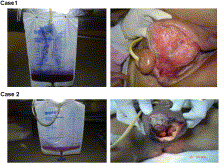Purple urine bag syndrome, not always a benign process
,
Department of Internal Medicine, Kaohsiung Medical University Hospital, Kaohsiung Medical University, Kaohsiung 807, Taiwan
1These 2 authors equally contribute in this work.
,
Department of Internal Medicine, Kaohsiung Medical University Hospital, Kaohsiung Medical University, Kaohsiung, Taiwan
Wen-Hsiung Hospital, Kaohsiung 807, Taiwan
Department of Urology, Kaohsiung Medical University Hospital, Kaohsiung Medical University, Kaohsiung 807, Taiwan
To view the full text, please login as a subscribed user or purchase a subscription. Click here to view the full text on ScienceDirect.

Fig. 1
Two patients had PUBS progressed to Fourier’s gangrene in Taiwan.
The subject of the case report presented by Su et al [1] is quite interesting as authors described a patient that was sent to the emergency department in critical condition upon arrival, and purple urine bag syndrome (PUBS) was also found at that time. Finally, the patient died of aspiration pneumonia and septic shock in the intensive care unit. The case report described the first case of PUBS that occurred involving a patient in critical condition. The authors claimed that PUBS was not the leading cause of mortality in this case.
To access this article, please choose from the options below
Purchase access to this article
Claim Access
If you are a current subscriber with Society Membership or an Account Number, claim your access now.
Subscribe to this title
Purchase a subscription to gain access to this and all other articles in this journal.
Institutional Access
Visit ScienceDirect to see if you have access via your institution.
© 2009 Elsevier Inc. Published by Elsevier Inc. All rights reserved.
Access this article on
Visit ScienceDirect to see if you have access via your institution.
Related Articles
Searching for related articles..


